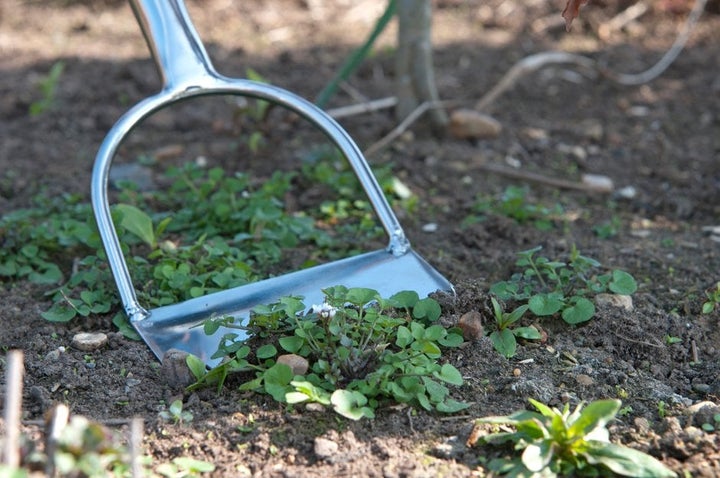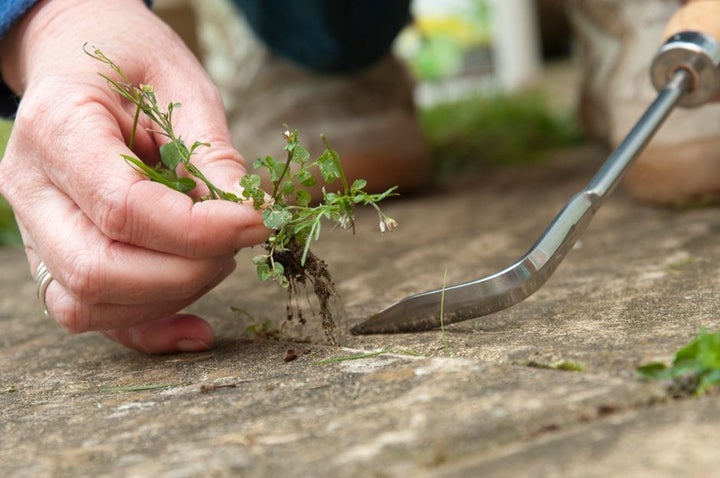
Quick facts
You’ll find two types of bittercress in gardens – Cardamine hirsuta is commonly called hairy bittercress, while Cardamine flexuosa is called wavy bittercress
Another common name for bittercress is ‘ping weed’, referring to how ripe seeds are propelled (pinged) away from the plant
If you need to control bittercress, non-chemical methods are easy and effective
What does bittercress look like?
- Hairy and wavy bittercress have flat of leaves. Each leaf stalk has smaller leaflets arranged down both sides, typically opposite each other
- Flowers are small and white, each with four petals. They usually bloom between spring and autumn, but both bittercresses are hardy so can grow and flower during mild spells in winter
Distinguishing between hairy and wavy bittercress isn’t essential, as both can be controlled with the same methods. But, if you are growing it for interest or as part of the plant diversity in your garden, these next tips will help you identify between them:
Hairy bittercress (C. hirsuta) is generally the smaller of the two, sometimes only reaching a height of 5cm (2in) tall, but the flower stalks are capable of reaching 30cm (1ft). It completes its life cycle, flowering and setting seed, in less than one year.

Wavy bittercress (C. flexuosa) can reach a height of around 50cm (20in) in damp conditions, but is shorter on dry soils. The stems of wavy bittercress veer alternately from side to side, as the name suggests. This bittercress can also live longer, growing as an annual or .

Did you know?
Despite its common name, the stems of hairy bittercress are generally a lot less hairy than the stems of wavy bittercress.
Is bittercress a weed?
Both hairy and wavy bittercress are UK wildflowers and attract various creatures, including moths, butterflies and hoverflies. In addition to increasing in your garden, bittercress is also a useful edible plant for humans – the leaves have a peppery, cress-like flavour and make a good addition to salads.
Bittercress may be unwanted in some garden situations, particularly veg patches and ornamental borders. It is a small plant, but can multiply easily by seed, making it a potential competitor for moisture, nutrients, space and light when growing among other small plants.
What is a weed?
The term ‘weed’ describes a plant that is growing where it isn’t wanted. Weeds usually thrive in average garden conditions, reproducing and spreading easily. It is up to you to decide what you call a weed and what you choose to retain or remove.
Frequently asked questions about controlling bittercress
Here are our answers to your most common questions about dealing with bittercress:
How invasive is bittercress?
Bittercress spreads by pinging seeds up to 1m (3ft) away from the parent plant. The seeds have a good chance of if they land on bare soil containing some moisture. However, plants are short-lived and have a shallow, fine root system, making them easy to hoe off or pull out. By removing plants before they set seed, you can easily clear an area of bittercress.
Do I need to get rid of bittercress?
You don’t need to eradicate bittercress from your garden. Among large, , it won’t have any detrimental effects. You can leave bittercress to grow in a designated wildflower patch or in unused, rarely visited parts of your garden. However, in an area where you wish to sow seeds or grow small plants, such as alpines, bittercress could cause unwelcome competition.
What is the easiest way to kill bittercress?
If you have bittercress growing where it is not wanted, there are a few easy ways to remove it:
- Hoe off plants – sharply slide the blade of a hoe just under the rosette of leaves to kill the whole plant. Hoe on a warm, dry or windy day, so exposed roots dry out quickly. removes weeds with minimal soil disturbance.
- Pull or fork out plants – this may be a good option if bittercress is growing among other and hoeing isn’t a feasible option. Hand pulling is usually easy, but on compacted soil you may need to use a hand fork.
- Smother plants – prevent seeds from germinating and growing by covering the soil with a mulch of organic matter about 8cm (3in) deep, or a mat of ground cover plants.


Should I use weedkiller?
As bittercress is easy to control by hoeing and pulling out, there’s no need to use a weedkiller.
For more information, see our page on Weeds: non-chemical controls.








